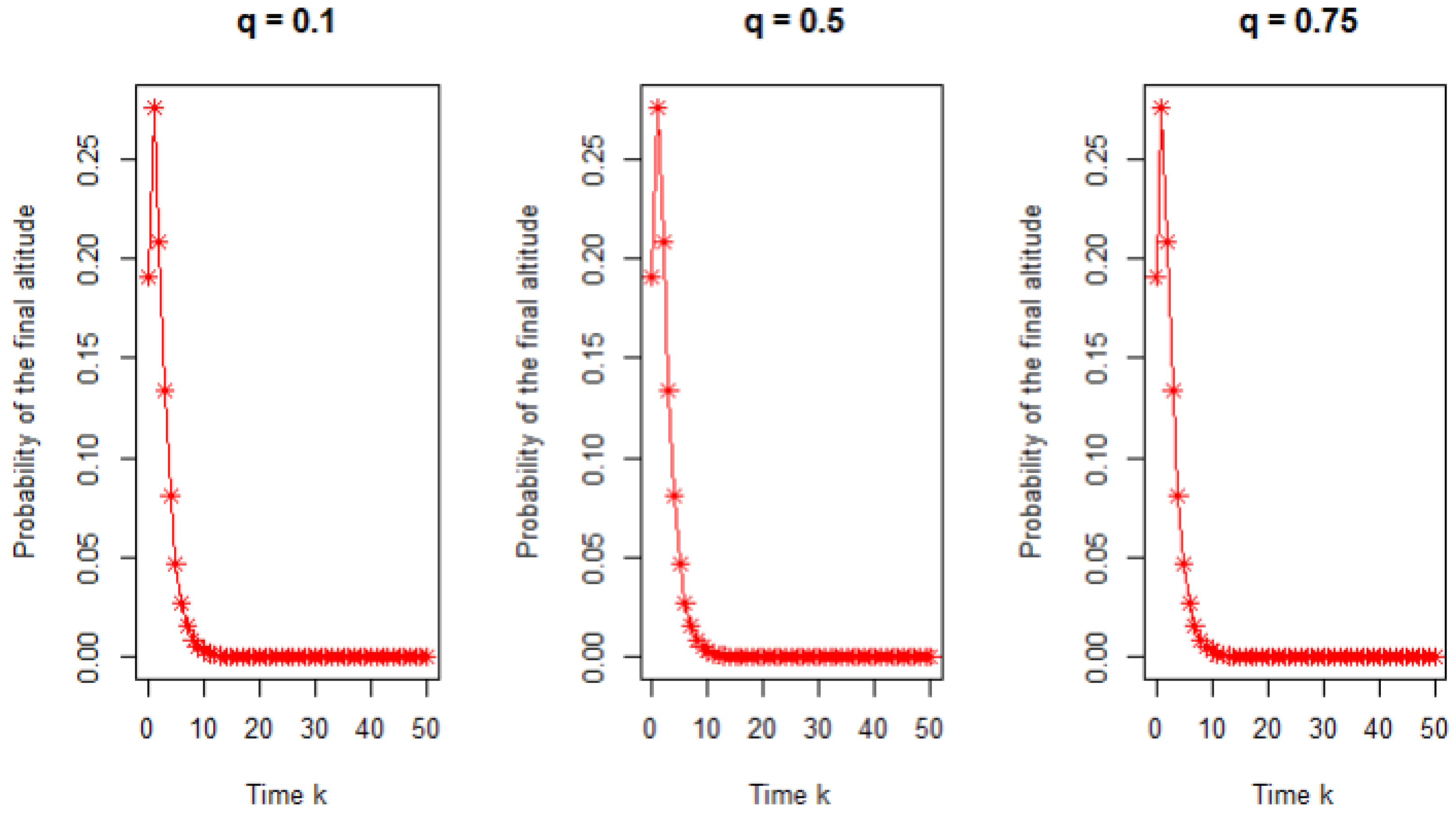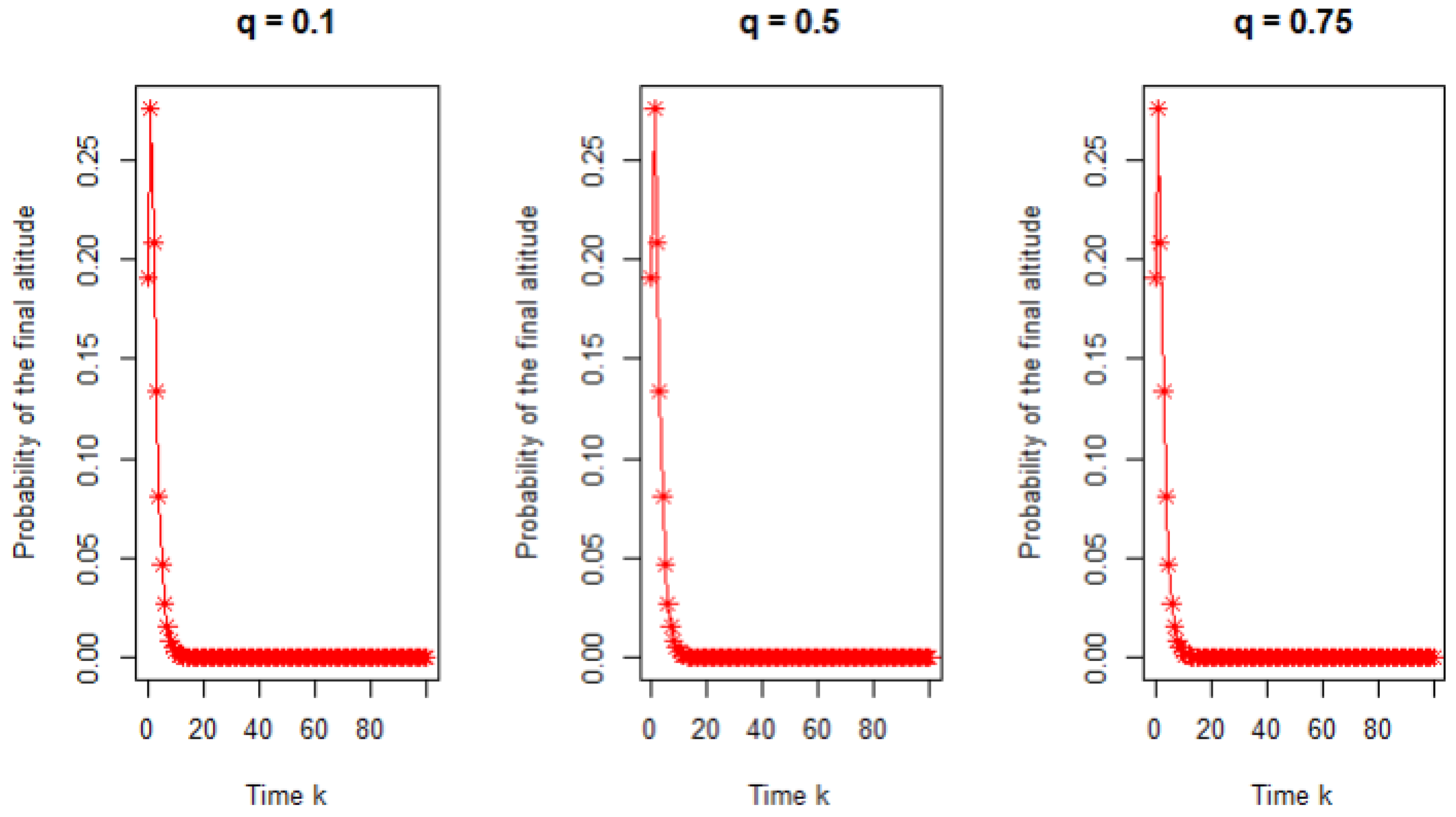Time-Dependent Probability Distribution of Two-Dimensional Moran Walk
Abstract
1. Introduction
2. Presentation of the Model and Its Applications
- (1)
- Allele Frequency Dynamics: The Moran model is frequently used to study the stochastic fluctuations in the frequency of genetic alleles in finite populations. It helps in understanding how genetic diversity changes over time due to random events such as genetic drift.
- (2)
- Evolutionary Biology—Neutral Evolution: The Moran model is a tool for studying neutral evolution, where genetic changes are not influenced by natural selection but rather by random processes such as genetic drift.
- (3)
- Ecology— Species Coexistence: In the context of ecological systems, the Moran model can be adapted to study the dynamics of competing species in a finite habitat. It provides insights into the factors influencing species coexistence or extinction.
- (4)
- Game Theory—Evolutionary Game Dynamics: The Moran process has been used to model evolutionary game dynamics, where strategies or traits in a population compete for reproduction success. It helps analyze the emergence and persistence of strategies in a population.
- (5)
- Application in Population Genetics: The two-dimensional Moran walk can be used to model the stochastic evolution of allele frequencies in a population where mutations and genetic drift play a role. The time-dependent transition probabilities allow for a more realistic representation of populations with variable mutation rates or selection pressures over time. The maximum altitude statistics derived in this work could be used to estimate the likelihood of a particular allele reaching fixation or extinction within a given number of generations. This approach is particularly relevant for studying populations undergoing rapid environmental changes, where mutation rates or selection pressures may change dynamically rather than remain constant.
3. Main Result
4. Simulation
5. Marginal Distribution of
6. Recursive Equations
7. Proofs
8. Conclusions and Perspective
- Extension to Higher Dimensions: While this work focuses on a two-dimensional setting, a natural extension would be to analyze the Moran walk in three or more dimensions. This generalization could provide a more comprehensive understanding of multidimensional population dynamics and other related stochastic processes.
- Derivation of Recurrence Relations: A key challenge is to establish explicit recurrence relations between the functions and that describe the evolution of height statistics. Extracting the coefficient would provide further insights into the distribution of and its limiting behavior.
- Asymptotic Analysis of Maximum Height: Determining the limiting behavior of as would be an important theoretical advancement. This could be achieved through generating function techniques, kernel methods, and singularity analysis.
- Moment Generating Function for Height Statistics: Using moment generating functions, we could obtain refined information about the mean and variance of . This approach would allow for a more comprehensive characterization of the distribution of the maximum altitude.
- Applications in Population Genetics and Evolutionary Biology: Given its origins in modeling genetic drift and allele frequency evolution, our Moran walk framework could be further adapted to incorporate selection effects, mutations, and varying population sizes. Such extensions would enhance the model’s applicability to real-world biological systems.
- Numerical Approximations and Machine Learning Approaches: The complexity of the recurrence relations and probability distributions suggests the potential benefit of employing numerical methods and machine learning techniques to approximate the behavior of the Moran walk under different parameter regimes.
Funding
Data Availability Statement
Acknowledgments
Conflicts of Interest
References
- Moran, P.A.P. Random processes in genetics. Proc. Camb. Philos. Soc. 1958, 54, 60–71. [Google Scholar] [CrossRef]
- Moran, P.A.P. The Statistical Processes of Evolutionary Theory; Oxford University Press: Oxford, UK, 1962. [Google Scholar]
- Lieberman, E.; Hauert, C.; Nowak, M.A. Evolutionary dynamics on graphs. Nature 2005, 433, 312–316. [Google Scholar] [CrossRef] [PubMed]
- Banderier, C.; Flajolet, P. Basic analytic combinatorics of directed lattice paths. Theor. Comput. Sci. 2002, 281, 37–80. [Google Scholar] [CrossRef]
- Flajolet, P.; Sedgewick, R. Analytic Combinatorics; Cambridge University Press: Cambridge, UK, 2009. [Google Scholar]
- Flajolet, P.; Guillemin, F. The formal theory of birth-and-death processes, lattice path combinatorics and continued fractions. Adv. Appl. Probab. 2000, 32, 750–778. [Google Scholar] [CrossRef]
- Drmota, M. Random Trees: An Interplay Between Combinatorics and Probability; Springer: Vienna, Austria, 2009. [Google Scholar]
- Abdelkader, M. On the Height of One-Dimensional Random Walk. Mathematics 2023, 11, 4513. [Google Scholar] [CrossRef]
- Banderier, C.; Nicodème, P. Bounded discrete walks. Discret. Math. Theor. Comput. Sci. 2010, AM, 35–48. [Google Scholar] [CrossRef]
- de Bruijn, N.G.; Knuth, D.E.; Rice, S.O. The average height of planted plane trees. In Graph Theory and Computing; Academic Press: Cambridge, MA, USA, 1972; pp. 15–22. [Google Scholar]
- Aguech, R.; Abdelkader, M. Two-Dimensional Moran Model: Final Altitude and Number of Resets. Mathematics 2023, 11, 3774. [Google Scholar] [CrossRef]
- Althagafi, A.; Abdelkader, M. Two-Dimensional Moran Model. Symmetry 2023, 15, 1046. [Google Scholar] [CrossRef]
- Huillet, T.E. Random walk Green kernels in the neutral Moran modelconditioned on survivors at a random time to origin. Math. Popul. Stud. 2016, 23, 164–200. [Google Scholar] [CrossRef]
- Huillet, T.; Möhle, M. Duality and asymptotics for a class of nonneutral discrete Moran models. J. Appl. Probab. 2009, 46, 866–893. [Google Scholar] [CrossRef]



| k | ||||||
|---|---|---|---|---|---|---|
| 0 | 1.0000000 | 0.1985929 | 1.0000000 | 0.191448 | 1.0000000 | 0.1914062 |
| 1 | 0.1000000 | 2.758942e-01 | 0.5000000 | 0.2758942 | 0.7500000 | 0.2758942 |
| 2 | 0.1462500 | 0.2084190 | 0.5312500 | 0.2084189 | 0.6093750 | 0.2084189 |
| 3 | 0.2071266 | 0.1340775 | 0.5478516 | 0.1340774 | 0.5808105 | 0.1340774 |
| 4 | 0.2807338 | 0.5558767 | 0.5701756 | |||
| 5 | 0.3598351 | 0.5595585 | 0.5657992 | |||
| 6 | 0.4327611 | 0.5612044 | 0.5639325 | |||
| 7 | 0.4889070 | 0.5619315 | 0.5631247 | |||
| 8 | 0.5248872 | 0.5622510 | 0.5627729 | |||
| 9 | 0.5446297 | 0.5623910 | 0.5626193 | |||
| 10 | 0.5543624 | 0.5624523 | 0.5625522 | |||
| 11 | 0.5588736 | 0.5624791 | 0.5625228 | |||
| 12 | 0.5609003 | 0.5624909 | 0.5625100 | |||
| 13 | 0.5617976 | 0.5624960 | 0.5625044 | |||
| 14 | 0.5621922 | 0.5624983 | 0.5625019 | |||
| 15 | 0.5623652 | 0.5624992 | 0.5625008 | |||
| 16 | 0.5624410 | 0.5624997 | 0.5625004 | |||
| 17 | 0.5624742 | 0.5624999 | 0.5625002 | |||
| 18 | 0.5624887 | 0.5624999 | 0.5625001 | |||
| 19 | 0.5624951 | 0.5625000 | 0.5625000 | |||
| 20 | 0.5624978 | 0.5625000 | 0.5625000 | |||
| 21 | 0.5624991 | 0.5625000 | 0.5625000 | |||
| 22 | 0.5624996 | 0.5625000 | 0.5625000 | |||
| 23 | 0.5624998 | 0.5625000 | 0.5625000 | |||
| 24 | 0.5624999 | 0.5625000 | 0.5625000 | |||
| 25 | 0.5625000 | 0.5625000 | 0.5625000 |
| n | ||||||
|---|---|---|---|---|---|---|
| 2 | 0.2927267 | 0.2576897 | 0.8662724 | 0.6625369 | 0.7634247 | 0.801805 |
| 3 | 0.4340728 | 0.3831944 | 1.295987 | 1.156994 | 1.305294 | 1.484398 |
| 4 | 0.6128307 | 0.5369151 | 1.590949 | 1.671204 | 1.639145 | 2.073645 |
| 5 | 0.8294468 | 0.7295031 | 1.784657 | 2.163199 | 1.831367 | 2.561173 |
| 6 | 1.071507 | 0.9698979 | 1.908665 | 2.594731 | 1.942151 | 2.937289 |
| 7 | 1.315971 | 1.264419 | 1.986578 | 2.946729 | 2.007359 | 3.213559 |
| 8 | 1.537325 | 1.61087 | 2.034805 | 3.217844 | 2.046565 | 3.410965 |
| 9 | 1.71805 | 1.991955 | 2.064301 | 3.417481 | 2.070489 | 3.549767 |
| 10 | 1.853148 | 2.376771 | 2.082165 | 3.559369 | 2.085199 | 3.646234 |
| 15 | 2.087933 | 3.585933 | 2.106694 | 3.814743 | 2.106639 | 3.821841 |
| 20 | 2.107294 | 3.819183 | 2.108445 | 3.843417 | 2.108426 | 3.843783 |
| 25 | 2.108498 | 3.84401 | 2.108563 | 3.846037 | 2.108561 | 3.846046 |
| 30 | 2.108567 | 3.8461 | 2.108571 | 3.846252 | 2.108571 | 3.846251 |
| 35 | 2.108571 | 3.846258 | 2.108571 | 3.846268 | 2.108571 | 3.846268 |
| 40 | 2.108571 | 3.846269 | 2.108571 | 3.846269 | 2.108571 | 3.846269 |
| 45 | 2.108571 | 3.846269 | 2.108571 | 3.846269 | 2.108571 | 3.846269 |
| 50 | 2.108571 | 3.846269 | 2.108571 | 3.846269 | 2.108571 | 3.846269 |
| 100 | 2.108571 | 3.846269 | 2.108571 | 3.846269 | 2.108571 | 3.846269 |
| 500 | 2.108571 | 3.846269 | 2.108571 | 3.846269 | 2.108571 | 3.846269 |
| 1000 | 2.108571 | 3.846269 | 2.108571 | 3.846269 | 2.108571 | 3.846269 |
Disclaimer/Publisher’s Note: The statements, opinions and data contained in all publications are solely those of the individual author(s) and contributor(s) and not of MDPI and/or the editor(s). MDPI and/or the editor(s) disclaim responsibility for any injury to people or property resulting from any ideas, methods, instructions or products referred to in the content. |
© 2025 by the author. Licensee MDPI, Basel, Switzerland. This article is an open access article distributed under the terms and conditions of the Creative Commons Attribution (CC BY) license (https://creativecommons.org/licenses/by/4.0/).
Share and Cite
Abdelkader, M. Time-Dependent Probability Distribution of Two-Dimensional Moran Walk. Symmetry 2025, 17, 1387. https://doi.org/10.3390/sym17091387
Abdelkader M. Time-Dependent Probability Distribution of Two-Dimensional Moran Walk. Symmetry. 2025; 17(9):1387. https://doi.org/10.3390/sym17091387
Chicago/Turabian StyleAbdelkader, Mohamed. 2025. "Time-Dependent Probability Distribution of Two-Dimensional Moran Walk" Symmetry 17, no. 9: 1387. https://doi.org/10.3390/sym17091387
APA StyleAbdelkader, M. (2025). Time-Dependent Probability Distribution of Two-Dimensional Moran Walk. Symmetry, 17(9), 1387. https://doi.org/10.3390/sym17091387





